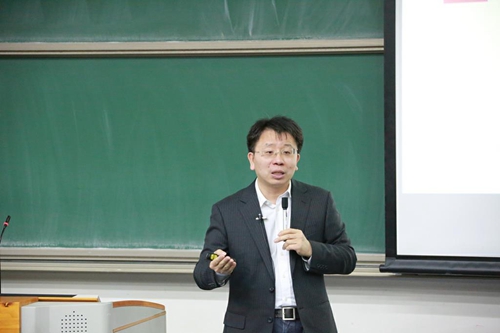Peking University, Apr. 21, 2017: On the evening of April 13, 2017, professor of the College of Urban and Environmental Sciences and deputy director of Peking University-Lincoln Institute of Urban Development and Land Policy Research Center, He Canfei, was invited to Caizhai Lecture Hall to give a speech on “How to Observe Economic Activities by Geography".
He analyzed the terminology system of location, place, region and network in the field of economic geography, introduced the spatial thinking of the "point-line-plane-network" of geography, and demonstrated the spatial angle to observe economy in a multi-level, multi-dimensional and multi-scale way. Peking University Graduate School Vice President Wang Tianbing presided over and attended the lecture.
At first, He introduced the concepts of geography and economic geography respectively. Geography is a science that describes and explains the spatial differences, interactions and changes in the surface of the Earth, while economic geography focuses on the spatial diversity of economic activities and its dynamic changes. Then, from the national and regional economic development level, each region's resource condition, population distribution, the world's major industrial types and volume and policy system these five aspects, he elaborated the common economic phenomenon that the economic activity space is not well-balanced.
Afterwards, He explained the terminology system of location theory, place, region and network in the domain of economic geography, and introduced the spatial thinking of "point-line-plane-network" in geography. He pointed out that the location of economic activities in space is not only the spatial equilibrium point of different costs, but also the equilibrium of different markets. We can understand the causes and factors of specific economic activities emerging in a geographical unit by analyzing its location. Place is the basic spatial unit of economic geography. If we see place in different scales, it will turn out to show diverse economic space structures. However, region is a spatial unit with a certain range, and its interior has a relatively consistent characteristic in some respects. Then he stressed the regional structure and regional division of labor in the regional differences of economic activities, and further analyzed the regional interaction and interdependence among regions. At the same time, he also pointed out that in the case of spatial differences and spatial links, global, regional and local networks have become an important way of thinking for economic geography.
At last, He summed up on how to understand the spatial structure of economic activities. He held that economic geography is to explore the relationships between the "economic-spatial" relationship of geography in different scales. To understand the spatial structure of economic activity, on one hand, we must have the basic thinking of "point-line-plane-network" to construct an abstract understanding of economic space. On the other hand, due to being the complex products of economy, society, environment and culture, "point-line-plane-network" in economic geography should be understood from the spatial perspective in a multi-level, multi-dimensional and multi-scale way.
After the lecture, He and students discussed about the reason for the uneven regional development and compared the characteristics of Fuzhou and Xiamen and other issues from the perspective of economic geography.
Written by: Liang Youle
Edited by: Wang Chengsiou
